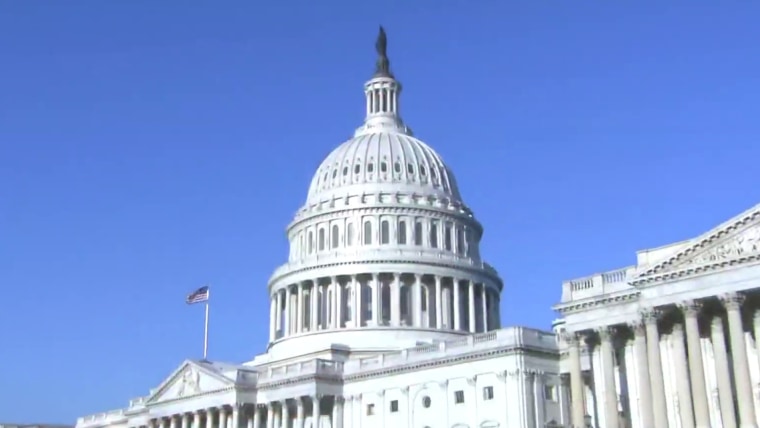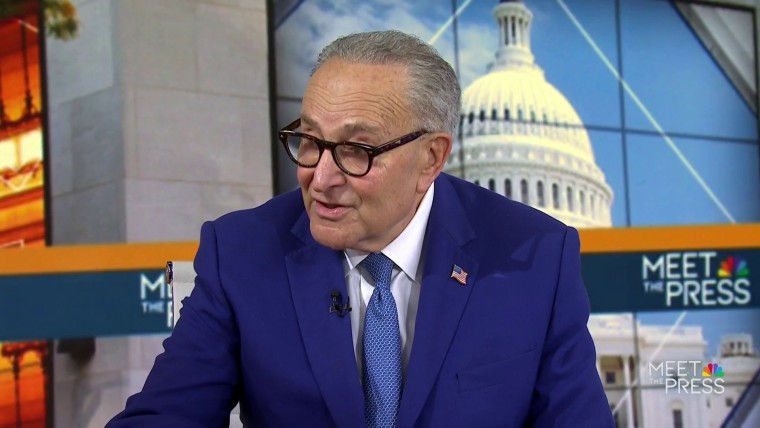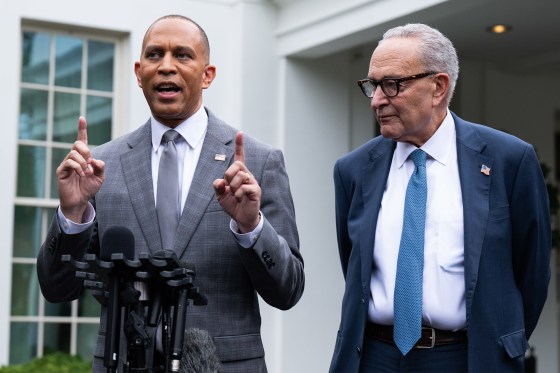House and Senate Democratic leaders Hakeem Jeffries and Chuck Schumer may be at very different stages in their leadership careers. But both New York Democrats have a lot to prove — and a lot to lose — in the high-stakes government shutdown battle.
For the 55-year-old Jeffries, this is his first real shutdown fight since taking the House reins from Nancy Pelosi 2 ½ years ago. While he was gearing up for a funding fight back in March, Schumer was not on board and ultimately helped Republicans keep the government open. Now, Jeffries — who has sometimes faced internal criticism for being too scripted and cautious — is fully leaning into the spending showdown with President Donald Trump and the GOP.
And the House Democratic caucus seems to be relishing in the shutdown swagger from their leader. At a closed-door caucus meeting Monday night, rank-and-file Democrats rallied behind Jeffries, giving him a pair of standing ovations as he reiterated that any deal with Republicans must include more health care funding, three members told NBC News.
“I think Hakeem is standing 100% on his own, and he is just resolute that Democrats are going to fight on behalf of the American people,” said Rep. Angie Craig, D-Minn., who is running for the Senate in 2026. “The health care notices are starting to come, the premium increases are starting to come. And, you know, Americans expect us to fight right now. And the president, he needs a deal. He’s the consummate deal maker, and he’s going to have to come get the deal."
“I’ve been saying from the start, the Senate can’t be a cheap date,” she continued.

The 74-year-old Schumer, who has led Senate Democrats since 2017, is no stranger to spending fights. Tuesday night's government funding deadline offers a chance for a do-over of sorts. Schumer faced fierce backlash from the Democratic base over his decision to vote with Republicans during the spring spending debacle, which fueled questions about whether he’d face primary or leadership challenges in the future. He is not up for re-election until 2028, but he’d have to run for Democratic leader again in the next Congress that begins in January 2027.
“We’re not doing enough,” Sen. Chris Murphy, D-Conn., who is seen as a potential leadership contender in the future, told NBC News on Friday.
Murphy did not mention Schumer by name but urged his party to “draw a line in the sand” in the funding fight.
“We have no obligation to fund the destruction of our democracy," he said. "So if this upcoming budget doesn’t include any provisions that push back against Trump’s lawlessness, I think people are going to scratch their heads if a bunch of Democrats sign on notwithstanding."
This government shutdown battle is not only a big test for each leader individually, but it’s also a major test for their relationship with each other. The two Brooklynites have a good working relationship, according to two sources close to both men, but they are still getting accustomed to working together as leaders.
After their public split in March, Jeffries and Schumer now appear to be on the same page in the fall funding fight — at least so far. Both leaders have remained firm in their position that they won’t supply the votes for the GOP’s seven-week stopgap funding bill unless it also includes some of their health care demands, such as extending the expiring Obamacare subsidies.
“Leader Schumer and I are in lockstep,” Jeffries said Monday. “House Democrats, Senate Democrats are in lockstep.”
But some Democrats remain nervous that Schumer may cave. He floated a seven-to-10-day stopgap funding bill on a conference call with Senate Democrats on Sunday as a contingency plan to reopen a potentially shuttered government, three people familiar with the private conversation told NBC News. Schumer raised the idea, in part, to give vulnerable moderates in his party something to vote for, one of the people said.

Some Democrats on the call viewed Schumer’s comments to mean that he may act to keep the government open — just like in March, when he said it would have been “much worse” to shut the government down than to vote for a Republican bill to keep it open.
That decision quickly caused an uproar among the Democratic base, and on Monday, Schumer’s temporary funding proposal received similar backlash after it became public. Asked about his plan after meeting with Trump, Schumer seemingly reversed course — telling reporters he would not support the weeklong CR.
“The time is a-wasting. We have to do it now,” Schumer said of their bid to restore certain health provisions. "We’ve delayed and delayed and delayed,” he said.
Schumer has a tougher path to winning control of the Senate in the 2026 election cycle than Jeffries, with several vulnerable members facing re-election and few opportunities to pick up Republican-held seats. And the Senate is ultimately where the Democratic votes are needed to avoid a shutdown, not the House, raising the stakes for Democrats in the upper chamber.
And unlike Jeffries, Schumer has decades of experience building relationships and getting members elected inside the Democratic caucus, which helped give him the confidence to make the risky move in March he knew wouldn’t be widely popular in his party.
Still, it left a sour taste in some Democrats’ mouths and many in the House lost confidence in Schumer. Six months later, those sentiments have not changed.
“If I had to put my money on someone caving, it’s not my guy. It’s not Hakeem,” one House Democrat said as he left the Monday caucus meeting, speaking on the condition of anonymity to speak candidly about the leaders.
Shutdown fights have a history of creating legacy-defining moments for the party leaders, although they carry a lot of risk as well.
Pelosi shepherded her party through a record-breaking, 35-day government shutdown during Trump’s first presidency in 2018 and 2019. She was widely praised by Democrats for how she navigated that fight, which helped cement Pelosi’s grip on the caucus at a time when she was facing some internal doubts. A viral picture of Pelosi strutting out of the White House after squaring off with Trump — clad in a red peacoat and black sunglasses — also helped further endear her with the left.
But Pelosi had far more experience than Jeffries and greater national stature at that time. By then, she had already made history as the first female speaker of the House, and she was on the cusp of becoming speaker again. (Pelosi had “clout,” as one congressional official put it.)
Some Democrats, however, said they don’t expect Jeffries to go mano a mano with Trump in the same way. The White House also opted not to have the cameras rolling when Trump sat down with the top four congressional leaders Monday — Jeffries' first substantive meeting with Trump — denying anyone a made-for-TV moment.
Jeffries “doesn’t have to go toe to toe. This is not a one-on-one basketball game. This is 214 plus 47 against one,” another House Democrat, who spoke on the condition of anonymity to discuss internal conversations, said referring to House Democrats and Senate Democrats, respectively. “Three weeks ago, when he came to us and said, ‘Health care is a thing,’ and there was some pushback — turns out health care really is a thing. Turns out he’s right.”
Jeffries has impressed his members with some of his play calls. While GOP leaders opted to keep the House out of session all week, Jeffries decided to haul his own members to Washington, where Democrats have been flooding the airwaves and stacking up press conferences — a move that earned him plaudits from his party.
While many Democrats in Washington are publicly endorsing the party’s hardball strategy, at least one has a different idea: Pennsylvania Sen. John Fetterman.
“What’s the fight? Plunging millions of Americans into chaos, that’s the fight?” he asked reporters Monday in the Capitol. “Win elections, you know? Hey, I mean, we should try that.”



